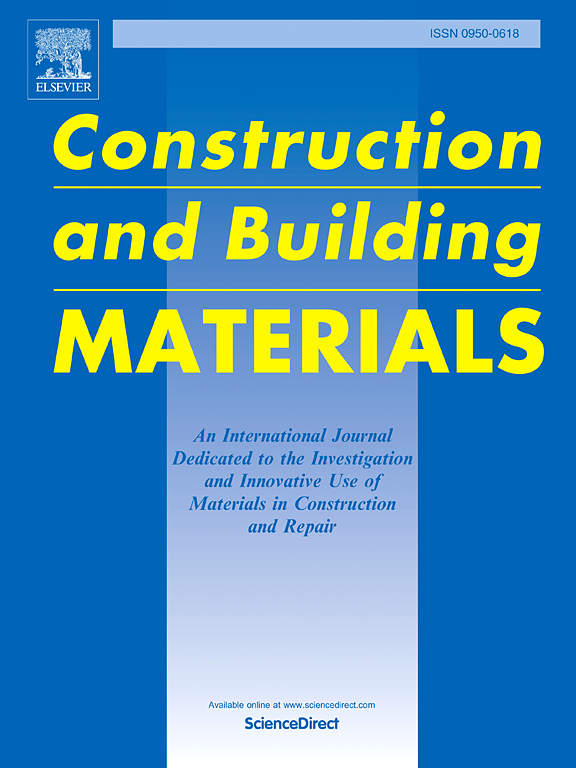Assessment of bond durability between GFRP bars and concrete produced with seawater under seawater exposure at different temperatures
IF 7.4
1区 工程技术
Q1 CONSTRUCTION & BUILDING TECHNOLOGY
引用次数: 0
Abstract
The growing interest in the use of Glass Fiber Reinforced Polymer (GFRP) bars to reinforce concrete structures, mainly due to their non-corrosion characteristics, allows for the development of more sustainable solutions in the production of reinforced concrete structures, such as using seawater instead of freshwater directly in the concrete composition. Through direct pullout tests (DPT), this work evaluated the bond durability of GFRP bars to concrete produced with seawater (SW) and freshwater (FW) after being subjected to seawater exposure at different temperatures, namely 20 °C, 40 °C and 60 °C, over two years. Unconditioned (reference) air-cured specimens were also tested for comparison. The mechanical properties of the constituent materials in the study, i.e., concrete and GFRP bars, and their influence on bond strength were also analyzed. Finally, the accuracy of existing formulations to predict the bond strength was assessed. The use of SW instead of FW resulted in a reduction in bond strength of approximately 43 % in unconditioned specimens, whereas only a 13 % reduction was observed in specimens conditioned for two years (SW versus FW). Additionally, exposure conditions did not cause significant changes in the failure modes nor with increasing temperature or time. Furthermore, the ACI provisions accurately predicted the bond strength of the two compositions studied.
使用玻璃纤维增强聚合物(GFRP)钢筋加固混凝土结构的兴趣与日俱增,这主要是由于它们具有不腐蚀的特性,因此可以在钢筋混凝土结构的生产中开发更具可持续性的解决方案,例如在混凝土成分中直接使用海水而不是淡水。通过直接拉拔试验(DPT),这项工作评估了 GFRP 钢筋与使用海水(SW)和淡水(FW)生产的混凝土在不同温度(20 °C、40 °C、60 °C)下经受海水暴露两年后的粘结耐久性。此外,还对未调理(参考)的空气养护试样进行了测试,以进行比较。研究还分析了组成材料(即混凝土和 GFRP 条)的机械性能及其对粘接强度的影响。最后,对现有配方预测粘结强度的准确性进行了评估。使用 SW 而不是 FW 会导致未调节试样的粘结强度降低约 43%,而在调节两年的试样中仅降低 13%(SW 与 FW 相比)。此外,暴露条件不会导致失效模式发生显著变化,也不会随着温度或时间的增加而发生变化。此外,ACI 规定准确预测了所研究的两种成分的粘结强度。
本文章由计算机程序翻译,如有差异,请以英文原文为准。
求助全文
约1分钟内获得全文
求助全文
来源期刊

Construction and Building Materials
工程技术-材料科学:综合
CiteScore
13.80
自引率
21.60%
发文量
3632
审稿时长
82 days
期刊介绍:
Construction and Building Materials offers an international platform for sharing innovative and original research and development in the realm of construction and building materials, along with their practical applications in new projects and repair practices. The journal publishes a diverse array of pioneering research and application papers, detailing laboratory investigations and, to a limited extent, numerical analyses or reports on full-scale projects. Multi-part papers are discouraged.
Additionally, Construction and Building Materials features comprehensive case studies and insightful review articles that contribute to new insights in the field. Our focus is on papers related to construction materials, excluding those on structural engineering, geotechnics, and unbound highway layers. Covered materials and technologies encompass cement, concrete reinforcement, bricks and mortars, additives, corrosion technology, ceramics, timber, steel, polymers, glass fibers, recycled materials, bamboo, rammed earth, non-conventional building materials, bituminous materials, and applications in railway materials.
 求助内容:
求助内容: 应助结果提醒方式:
应助结果提醒方式:


